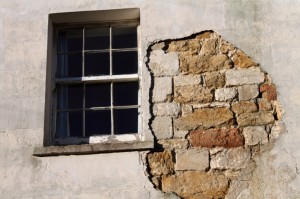You are about to buy your ideal home, but are there any property defects lurking under the surface? Robin Johnson, managing director of Kinleigh Folkard & Hayward Chartered Surveyors, explains the different types of surveys available, and which one could be right for you.
 Buying a house is, for most people, a very emotional decision which may help explain why some very sensible thinking can fly out of the window. Nowhere is this more apparent than in most buyers’ decision to ignore getting a survey for the property of their dreams.
Buying a house is, for most people, a very emotional decision which may help explain why some very sensible thinking can fly out of the window. Nowhere is this more apparent than in most buyers’ decision to ignore getting a survey for the property of their dreams.
Given this is the most important purchase most of us make, very few decide to get the full picture on the property they want to buy – leaving them open to often avoidable and substantial costs after purchase.
It is a big problem and in a market where house prices are stretching buyers to the limit, it seems all the more incredible that this investment does not warrant protection for what is effectively a fraction of the property’s value.
According to the HomeOwners Alliance, only 20 per cent of people get a professional property survey before buying a new home. Although they may seem costly, and can sometimes lead to delays, having a survey could also mean avoiding a lot of expense and stress if you are smart about it.
Hundreds of thousands of homebuyers will move over the next year without undertaking a survey to find out if their next property is in good condition. This is because most buyers do not know about or are not willing to pay for a survey and most believe that their mortgage lender’s standard valuation is sufficient, although it says nothing about the building’s state of repair.
There is a theory that the incidental costs of buying a house can put people off getting a survey. With legal and conveyancing fees, mortgage deposit, stamp duty and moving costs, an extra £200 to £300 for a private Home Buyer’s survey might be enough to deter many from going ahead.
Now this may be a false economy but I suspect the real reason is not actually financial. It is probably borne out of most buyers’ belief that the mortgage valuation is enough and that it affords greater protection to the buyer than it does in reality.
Five types of survey
There are five different levels of surveys to consider when buying a home. Some are unavoidable but others, although not a legal requirement, are worth considering so you fully understand the condition and safety of the property.

Mortgage valuation
If you ask most buyers whether they have had a survey done many will assume the lender’s mortgage valuation report (for which they paid) means they already have. In spite of the different name, homebuyers mistakenly believe the mortgage lender’s valuation also acts as their survey.
While lenders continue to release copies of valuation reports to buyers – and let’s face it, if they are charging consumers for the report it is hard to deny them the privilege of seeing it – there is little incentive to look further.
The basic valuation simply tells the lender that they are not lending more than the property is worth and that, if sold by you, it will make back the amount borrowed. Some mortgage lenders even waive the fee for the basic valuation as part of a package to attract your custom.
The key thing to remember is that a mortgage valuation, whether you pay for it or not, is done for the lender’s benefit, not yours, and is effectively a condition of you receiving a mortgage offer.
It is worth mentioning that the best time to have a survey carried out is when you have an offer accepted on a property. Then it is important to find out about the condition of the building and make sure that it’s worth the price you have offered. The level of survey you need depends a lot on the individual property you are buying.
HomeBuyer Report

The RICS (Royal Institution of Chartered Surveyors) introduced the current RICS HomeBuyer Report (HBR) in July 2009.
It is designed to be user-friendly and for the most part avoids technical jargon and employs a helpful three colour-coded condition ratings scheme which is likened to a traffic light system. Designed in consultation with consumers, it was welcomed for its clarity.
The first condition rating, green, means no repair is currently needed on the property and it should be maintained in the normal way; the second, amber, highlights defects that need repairing or replacing but are not considered to be either serious or urgent; the last, red, pinpoints serious defects that need to be repaired, replaced or investigated urgently.
It is cheaper than a full structural survey and offers detailed information. Like the Condition Report (a simplified version of the HomeBuyer Report), it comes with a rating system for the property and is likely to include professional support or further explanation from the surveyor after the inspection. It is most suitable for properties built in the past 100 years.
The report is detailed and lengthy but don’t let that put you off. It is divided into easily readable and logical sections and, importantly, includes a number of appendices which tell buyers, or any legal advisers, what they ought to do next.
Probably the most important section, or at least the one we would all look at first, is the surveyor’s overall opinion of the property and whether or not the surveyor considers the agreed purchase price to be reasonable.
Of equal note is the section related to energy efficiency and the Energy Performance Certificate that must be prepared before a property is marketed.
Elsewhere there is an overview of the condition of the services based on a visual inspection. The surveyor will not test the services as, for example, if the property is vacant the services may have been turned off or disconnected but the surveyor will recommend further investigations if these are considered appropriate.
Lastly, though no less importantly with an ageing housing stock in the UK, will be any risks to the building, grounds or occupants. This could cover such problems as potential flooding, the presence of asbestos-based materials, an unprotected pond that could be a danger to small children or lack of safety glazing to doors.
Condition Report
RICS also offers a product called a Condition Report. This is a simplified version of the HomeBuyer Report and includes many of the elements discussed in that report and in a similar format.
The most significant difference is that the Condition Report does not include a valuation of the property or advice on future repairs and maintenance and is essentially a concise ‘entry level’ survey. It operates a traffic light or 1-2-3 system to rate aspects of the property, with a red light or number three emphasising serious defects.
It should flag up problems regarding structural movement as well as damp or woodworm. It is not exhaustive and may signpost areas needing attention without detailing what repairs are needed. Neither a property valuation, nor professional advice from a surveyor following the inspection, is included.
Buildings Survey
 The Buildings Survey is the most comprehensive available. It is suitable for any building, but is especially recommended for older buildings or those constructed out of unconventional materials. Buildings surveys are not property type or age specific.
The Buildings Survey is the most comprehensive available. It is suitable for any building, but is especially recommended for older buildings or those constructed out of unconventional materials. Buildings surveys are not property type or age specific.
For most houses or flats built of traditional stone or brick construction and in apparent good condition, a HomeBuyer Report is more than enough. Buildings Surveys are for properties of unusual construction; in dilapidated condition; of historical importance, for example, listed building status, or where extensive renovation is planned.
The surveyor will examine the soundness of the structure, its general condition and all major or minor faults. More specialist surveys can also be carried out on aspects such as foundations, damp proofing, or tree roots, either by a specialist within the firm of surveyors or by an independent specialist surveyor. The report is extremely thorough as surveyors are legally obliged to inform you of all the findings of the survey.
A full Buildings Survey normally takes much longer than the one or two hours required for the HomeBuyer’s Report. The survey report can also take a long time to produce.
A Buildings Survey costs anything up to £1,000, again depending on the price of the house. It remains the standard for surveys and is the most comprehensive survey available. It will provide detailed information about the condition of a home, highlight defects and offer advice on repairs and maintenance.
Snagging survey
 Finally, if you are buying a new-build, it should have passed building regulation inspections and have a certificate from an insurance company such as the National House Building Council.
Finally, if you are buying a new-build, it should have passed building regulation inspections and have a certificate from an insurance company such as the National House Building Council.
This doesn’t mean it doesn’t need checking, though. A snagging survey looks for mistakes made by building contractors, such as poorly painted walls or missing screws on door hinges.
The benefit of this survey is that by ensuring on exchange that completion is subject to fixing any problems highlighted in a snagging survey, the developer would need to put these things right to get their money.
Benefits
The benefits of private surveys are fairly clear. Surveys have been proven to save buyers money – and this trend will continue. A survey might seem like another expense, but you will kick yourself if you have to pay out thousands of pounds later on for major repairs of faults you didn’t know about when you bought the property.
Remember that with the cost for a day’s work by a skilled person averaging £200 plus VAT per day or the price of a new window frame at £300 plus VAT, private surveys are much more affordable investments than you might think.
Our ageing housing stock, which makes up by far the majority of homes in the UK, and an increasing focus upon sustainability should, over time, encourage more buyers to seek out independent advice rather than rely on the mortgage lender’s valuation report.
The reality is, the person who carries out the survey for you is one of the few people involved in the buying process that is solely on your side.
Unlike the agent you buy through, the lender who gives you your mortgage or the insurance company, a thorough survey on your property means you have one person to call if there is a problem with the property of which you weren’t aware.

Without them, you are very much on your own.
Whether you see surveys as an investment or insurance item, they very often pay for themselves. The key is knowing what to do with the information they reveal.
As household budgets tighten, it may be tempting to ignore private surveys and focus entirely on the deposit for your mortgage. Look beyond the initial outlay and let professionals make sure that your dream home does not turn into a nightmare.




